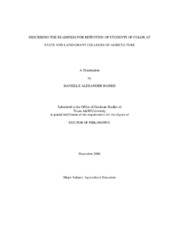| dc.description.abstract | Current demographics indicate that populations of color are on the rise across the United States. Although enrollments of students of color are increasing, first year retention rates are lower compared to their peers. Consequently, systemic changes are needed to produce changes in services and programs required by these students. Despite the modest gains in enrollment, students of color remain underrepresented at every degree level in higher education. Despite volumes of research, institutions still disregard the seriousness of the problem and continue to address retention with isolated programmatic approaches to change administrative, instructional, and advising practices with little evaluation. The purpose of this study was to develop an instrument assessing the organizational readiness of state and land-grant universities to retain students of color in colleges of agriculture as well as determine what definitions of retention were used to support existing retention programs and services. Since state and land-grant institutions previously engaged in retention strategies, an ex post facto study was conducted. A census of the population was conducted, where close to half of the population responded and expressed interest in seeing study results. State and land-grant colleges were selected as participants due to their unique inability to reach higher than average retention rates of students of color, specifically in agricultural fields. Statistical tests such as t-tests and analysis of variance were used to analyze data and further refine the instrument. Reliability for each of the instrument scales was high. However, further refining must be done before the instrument will more precisely indicate where gaps are in each readiness area in colleges of agriculture. This study determined that more information is needed on which definitions of retention are used to support programs and services within the college. Further investigation should be done to ascertain why more organizational diagnostic assessments are not done in this area considering the fiscal impacts on priorities such as retention. Although respondents indicated satisfaction with the college of agriculture to meet the academic needs of students, departmental administrators and faculty were still unclear of their role with retention. These findings indicate more research in this area should be conducted. | en |


